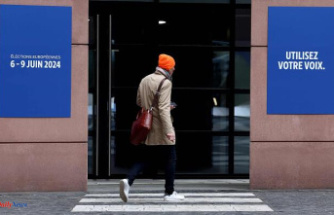With glue and tomato soup, climate activists have been drawing attention to their demands in art exhibitions for weeks. Museums are worried about their works. The Kunstsammlung NRW has now packed a special emergency kit just in case.
Düsseldorf (dpa/lnw) - cotton wool, Vaseline, absorbent cloths: restorers in the North Rhine-Westphalia art collection have packed an emergency kit so that they can react quickly if climate activists attack the works of art. After activists stuck to pictures in several museums or poured liquids on them, the art collection in Düsseldorf also developed an emergency plan. "This also includes the emergency kit," said spokeswoman Susanne Fernandes on Thursday.
Specialists from the restoration department have packed absorbent cloths in the case - which is actually more of a large plastic container - so that liquids can be wiped off a work of art. Nail polish remover, vegetable oil and petroleum jelly are also included. They could help when activists get stuck on a work of art, explained chief restorer Nina Quabeck. The set also includes a special screwdriver that can be used to quickly remove a valuable picture from the wall if necessary.
"If something happens, we have to be able to react quickly. It's not called "superglue" for nothing. The longer it has to dry, the better it holds," explained Quabeck.
However, in an emergency, despite the time pressure, the experts would also have to keep an eye on some legal aspects, said spokeswoman Fernandes. "If a picture is affected, we first have to clarify who owns it. We have a lot of items on loan. In such a case, we have to clarify with the owner what steps we can take at all." If activists were to stick to a work, the restorers would also have to be careful not to touch the activists when removing their hands - only rescue workers or the police would be allowed to do that.
But it is also clear that every attack on works of art causes damage. "It can only be about minimizing the damage to an image," said Fernandes. With stricter measures when entering the exhibition halls, the art collection therefore wants to prevent protest actions against the exhibited works from the outset, if possible.
Climate activists have recently caused a stir in Germany and other countries with their actions in museums and concert halls. Among other things, tomato soup was thrown in the direction of Vincent van Gogh's work "Sunflowers" in London. The work was protected by a pane of glass. In Vienna, the painting "Death and Life" by Gustav Klimt - also protected with glass - was covered with oil. One of the activists stuck his hand to the protective glass.
As a result, numerous museums in North Rhine-Westphalia have tightened their security precautions. Among other things, there are bag checks at the entrance or visitors have to leave their backpacks and jackets in the cloakroom.
First, "Bild" reported on the Düsseldorf emergency kit.












